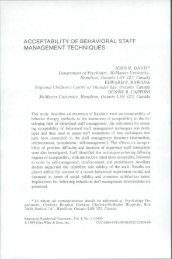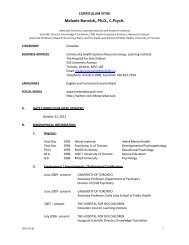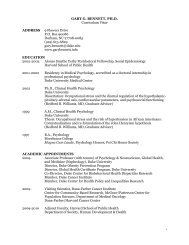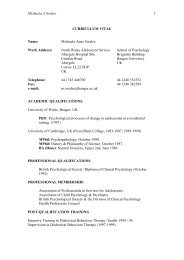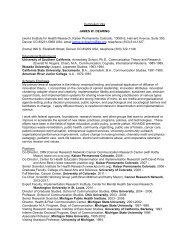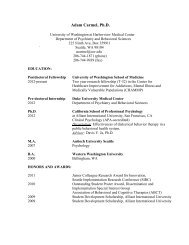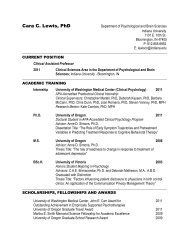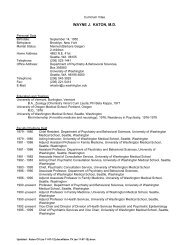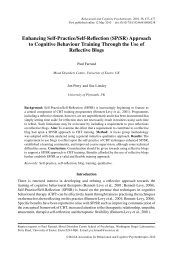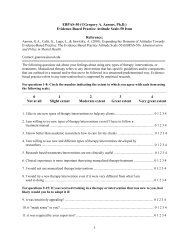The Cross-Level Effects of Culture and Climate in Human Service ...
The Cross-Level Effects of Culture and Climate in Human Service ...
The Cross-Level Effects of Culture and Climate in Human Service ...
Create successful ePaper yourself
Turn your PDF publications into a flip-book with our unique Google optimized e-Paper software.
CULTURE AND CLIMATE 779<br />
Passive-defensive cultures promote protective, reactive behavior <strong>and</strong> encourage <strong>in</strong>teractions that<br />
meet lower security needs (Cooke& Szumal, 2000). Passive-defensive culture was measured by scales<br />
that assess approval/consensus norms (e.g., 'do th<strong>in</strong>gs for the approval <strong>of</strong> others'), conventional/conformity<br />
norms (e.g., 'accept the status quo'), <strong>and</strong> dependent/subservient norms (e.g., 'be a good follower').<br />
<strong>The</strong> alpha reliabilities for these scales (shown <strong>in</strong> Table 2) were 0.86 (approval/consensus),<br />
0.81 (conventional/conformity), <strong>and</strong> 0.75 (dependent/subservient).<br />
<strong>Climate</strong><br />
<strong>Climate</strong> was measured with several well-known scales developed from the Psychological <strong>Climate</strong><br />
Questionnaire assembled by James <strong>and</strong> Sells (1981). <strong>The</strong> selected scales were l<strong>in</strong>ked <strong>in</strong> earlier research<br />
to the quality <strong>and</strong> outcomes <strong>of</strong> services <strong>in</strong> child welfare <strong>and</strong> juvenile justice organizations (Glisson &<br />
Hemmelgarn, 1998). Positive climates are perceived by case managers as low <strong>in</strong> depersonalization<br />
(e.g., 'I worry that this job is harden<strong>in</strong>g me'), emotional exhaustion (e.g., 'I feel used up'), <strong>and</strong> role<br />
conflict (e.g., 'I do th<strong>in</strong>gs that are aga<strong>in</strong>st my better judgment'). Table 2 shows the alpha reliabilities for<br />
these dimensions were 0.69 (depersonalization), 0.92 (emotional exhaustion), <strong>and</strong> 0.87 (role conflict)<br />
with this sample.<br />
Structure<br />
Structure was measured with scales developed from Hall's (1963) orig<strong>in</strong>al work that have been used<br />
for over two decades <strong>in</strong> human service organizations (e.g., Glisson, 1978; Glisson & Mart<strong>in</strong>, 1980;<br />
Mart<strong>in</strong> & Glisson, 1989). Centralization is the extent to which authority <strong>and</strong> decision-mak<strong>in</strong>g is limited<br />
<strong>and</strong> hierarchical with<strong>in</strong> the work unit (e.g., <strong>in</strong>verse <strong>of</strong> 'I am my own boss'). Formalization is the<br />
extent to which formal organizational rules, regulations, <strong>and</strong> procedural specifications guide the activities<br />
<strong>in</strong> the work unit (e.g., 'we follow strict operat<strong>in</strong>g procedures'). <strong>The</strong> alpha reliabilities (Table 2) for<br />
these dimensions <strong>of</strong> structure were 0.78 (centralization) <strong>and</strong> 0.74 (formalization) with this sample.<br />
Work attitudes<br />
Work attitudes were measured with scales based on the organizational commitment scale (e.g., 'I put <strong>in</strong><br />
a great deal <strong>of</strong> effort to help this organization') orig<strong>in</strong>ally developed by Porter, Steers, Mowday <strong>and</strong><br />
Boulian (1974) <strong>and</strong> the job satisfaction scale (e.g., 'I am satisfied with the chance to use my abilities'),<br />
orig<strong>in</strong>ally developed by Hackman <strong>and</strong> Oldham (1980). <strong>The</strong>se scales were used <strong>in</strong> previous research<br />
with similar human service organizations <strong>and</strong> found to be related to a variety <strong>of</strong> job <strong>and</strong> organizational<br />
characteristics (Glisson& Durick, 1988). <strong>The</strong> alpha reliabilities (Table 2) for these dimensions <strong>of</strong> work<br />
attitudes were 0.85 (job satisfaction) <strong>and</strong> 0.88 (organizational commitment) with this sample.<br />
<strong>Service</strong> quality<br />
<strong>Service</strong> quality was measured with eight items developed specifically for child welfare <strong>and</strong> juvenile<br />
justice organizations. <strong>The</strong> items reflect a model <strong>of</strong> service provision developed by a group <strong>of</strong> experts<br />
assembled by <strong>The</strong> University <strong>of</strong> Tennessee Children's Mental Health <strong>Service</strong>s Research Center that<br />
emphasizes service availability, responsiveness <strong>and</strong> cont<strong>in</strong>uity. <strong>The</strong> eight items were designed to assess<br />
such perceptions <strong>of</strong> case managers as whether or not they are able to 'be available to each child,' 'be<br />
responsive to the needs <strong>of</strong> each child,' 'place the well-be<strong>in</strong>g <strong>of</strong> children first,' <strong>and</strong> 'act <strong>in</strong> the best <strong>in</strong>terest<br />
<strong>of</strong> each child.' Each team member <strong>in</strong> the study responded to these items <strong>and</strong> the alpha reliability for<br />
the measure <strong>of</strong> service quality was 0.92.<br />
Turnover<br />
Turnover was measured one year after the adm<strong>in</strong>istration <strong>of</strong> the <strong>in</strong>struments described above. After one<br />
year, case management team leaders <strong>and</strong> members <strong>of</strong> the case management teams were contacted to<br />
Copyright ) 2002 John Wiley & Sons, Ltd.<br />
J. Organiz. Behav. 23, 767-794 (2002)




